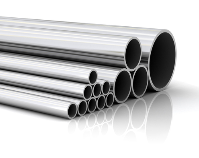- Home
- >
- Industry News
- >
- Why stainless steel rust?
Why stainless steel rust?
When the surface of stainless steel pipe brown rust (point), when people were amazed: that "stainless steel is not rusty, rust is not stainless steel, and may be a steel problem." In fact, this is a lack of understanding of the stainless steel one-sided misconceptions. Stainless steel in certain conditions will rust.
Stainless steel has the ability to resist atmospheric oxidation --- that is, stainless steel, but also has acid, alkali, salt medium is the ability to corrosion - that corrosion resistance. But its corrosion resistance is the size of the steel itself with the chemical composition, plus the state of each other, the use of environmental conditions and the type of media changes. Such as the 304 steel pipe, in the dry and clean atmosphere, there is absolutely good anti-corrosion ability, but it moved to the coastal areas, containing a lot of salt in the sea fog will soon rust; and 316 steel performance good. Therefore, not any kind of stainless steel, in any environment can be resistant to corrosion, no rust.
The surface membrane is damaged in many forms, more common in daily life are the following:
Stainless steel is formed by its surface layer of thin and strong fine and stable chromium-rich oxide film (protective film), to prevent the continued infiltration of oxygen atoms continue to oxidation, and access to anti-corrosion ability. Once there is some reason, this film has been constantly destroyed, air or liquid oxygen atoms will continue to penetrate or the metal in the iron atoms from the continuous analysis out of the formation of loose iron oxide, the metal surface will continue to rust.
This surface membrane is damaged in many forms, more common in daily life have the following:
1. stainless steel surface containing other metal elements containing dust or dissimilar metal particles attached to the material, in the humid air, the adhesion between the condensate and stainless steel, the two together into a micro-cell, triggering an electrochemical reaction , The protective film is damaged, called electrochemical corrosion.
2. Stainless steel surface adhesion organic juice (such as vegetables, noodles, etc.), in the case of water and oxygen, constitute organic acids, organic acids for a long time on the metal surface corrosion.
3. Stainless steel surface adhesion containing acid, alkali, salt substances (such as alkaline water, lime water splash), causing local corrosion.
4. In a polluted air (such as containing large amounts of sulfide, carbon dioxide, nitrogen oxide atmosphere), the case of condensation, the formation of sulfuric acid, nitric acid, acetic acid liquid point, causing chemical corrosion.

To ensure that the metal surface permanently bright, not to be rusted, we recommend:
The above situation can cause stainless steel surface protective film damage caused by corrosion. Therefore, to ensure that the metal surface permanently bright, not to be rusted, we recommend:
1. The surface of stainless steel must always be cleaned and scrubbed to remove attachments, eliminating the external factors lead to modification.
2. Seaside areas to use 316 stainless steel, 316 material can resist seawater corrosion.
3. Some stainless steel pipe on the market chemical composition can not meet the corresponding national standards, less than 304 material requirements. So it will cause rust, which requires users to seriously choose a reputable manufacturers of products
Why stainless steel with magnetic?
It is often thought that the magnet adsorption of stainless steel, to verify the pros and cons and the authenticity of non-smoking non-magnetic, that is good, true; suction are magnetic, is considered counterfeit. In fact, this is a very one-sided, unrealistic error identification method.
A wide range of stainless steel at room temperature according to the organizational structure can be divided into several categories:
1. Austenitic type: such as 301,304,316, etc .;
2. Martensite or ferrite type: such as 430,420,410;
Austenitic type is non-magnetic or weak magnetic, martensite or ferrite is magnetic.
Usually used as decorative tubesheet stainless steel is mostly austenitic 304 material, in general is not magnetic or weak magnetic, but due to smelting caused by fluctuations in the chemical composition or processing status may also be different magnetic, but this can not be considered Counterfeit or unqualified, what is the reason?
The above-mentioned austenite is non-magnetic or weak magnetic, and martensite or ferrite is magnetic, due to segregation or smelting improper heat treatment will result in austenitic 304 stainless steel in a small amount of martensite or ferritin Body tissue. In this way, 304 stainless steel will be with a weak magnetic.
In addition, 304 stainless steel after cold, the organizational structure will be transformed into martensite, the greater the degree of cold deformation, the more martensitic transformation, the greater the magnetic steel. As a number of strip, the production of Φ76 tube, no obvious sense of magnetic, production Φ9.5 tube. Due to Ling bending deformation of the larger magnetic induction on the obvious, the production of rectangular tube deformation due to large than the tube, especially the angle part of the deformation is more intense magnetic more obvious.
In order to completely eliminate the above-mentioned causes of 304 steel magnetic properties, can be restored by high temperature solution treatment stability of austenite, thereby eliminating the magnetic.
In particular, due to the above reasons, the magnetic properties of 304 stainless steel, and other materials of stainless steel, such as 430, carbon steel magnetic is not the same level, that is 304 steel magnetic always shows weak magnetic.
This tells us that if the stainless steel with a weak magnetic or completely non-magnetic, should be identified as 304 or 316 material; if the same magnetic steel, showing a strong magnetic, because the judge is not 304 material.
Related recommendation:
The performance characteristics of hydraulic hammer valve
Product recommendation:
200PSI CF8M Threaded Gate Valve
ANSI Stainless Steel Globe Valve DN100
API Stainless Steel Floating Flange Ball Valve




;)
;)




